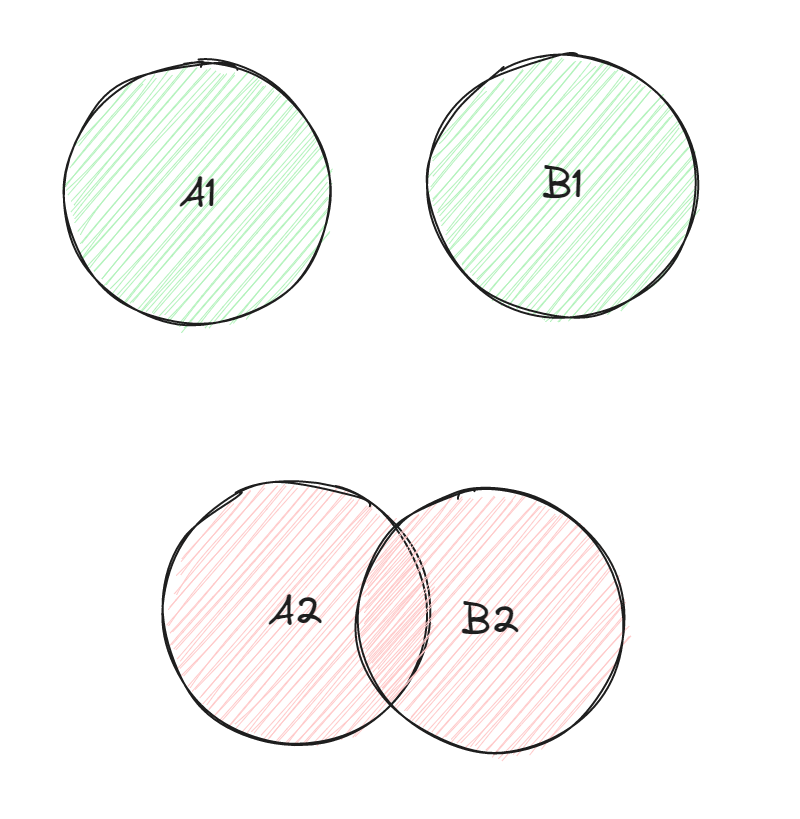TypeScript 的类型运算
上一节我们介绍了 TypeScript 的数据类型,这一节我们讲讲 TypeScript 的类型运算。在 JavaScript 中,我们有对值进行各种运算,在 TypeScript 中,怎么对类型进行运算
联合类型(并集)
联合类型(Union Types)表示取值可以为多种类型中的一种
多说无益,看例子说话:
type A1 = number;
type B1 = string;
type C1 = A1 | B1;
const c1: C1 = "hi";
type A2 = { name: string };
type B2 = { age: number };
type C2 = A2 | B2;
const c2: C2 = {
name: "johan",
age: 30,
};
const c3: C2 = {
name: "elaine",
};
看例子和图我们能明白,它是并集。像 c3 它只有 name 值,也属于类型 C2 的范围
类型收窄
联合类型是为了扩大我们的选择,而与之对应的是类型收窄。类型收窄的目的是将类型范围缩小到具体的类型,例如:
type Fruit = "apple" | "banana" | "orange";
function getFruit(frite: Fruit): void {
if (fruit === "apple" || fruit === "orange") {
console.log(fruit.toUpperCase()); // fruit 的类型此时会缩小为 "apple" 或 "orange"
} else {
console.log(fruit.length); // fruit 的类型此时会缩小为 "banana",因为 "banana" 是唯一剩下的类型
}
}
getFruit("apple"); // 输出 "APPLE"
getFruit("banana"); // 输出 6上面的示例中,当 fruit 的值为 apple 或者 orange 时,它的类型就会被收窄为 apple 或者 orange。我们通过 if...else 逻辑来收窄类型
同理,使用 typeof 也能区分类型,这个 JavaScript 中的类型判断一样,如果你看过笔者写的这篇文章——JavaScript 由什么组成,就能明白 typeof 的虽然能检测出 string、number、boolean、undefined 以及 function,但是不能检测 null 以及除 function 外的对象
除了 typeof 外,我们还能通过 instanceof 来判断类型,他虽然能检测出引用类型(object对象),但是它不能判断基本数据类型和 TS 独有的类型
而在 TypeScript 中,我们还可以使用 in 来收窄类型
type Person = {
name: sring
}
const f1 = (a: Person | Person[]) => {
if ('name' in a) {
a // Person
} else {
a // Person[]
}
}但这个方法只适用于部分对象
我们还可以通过 JavaScript 中判断类型的函数类区分类型
const f1 = (a: string | string[]) => {
if (Array.isArray(a)) {
a.join('\n').toString()
// a 的类型为 string[]
} else if (typeof a === 'string'){
parseFloat(a).toFixed(2)
} else {
throw new Error('Never do this')
}
}但它也有局限,就是不是每个类型都有判断类型的方法,像Array 有 isArray 方法,但是 Object、Function、Date、String、Number 等类型都没有响应的类型自带判断方法,所以它局限性很大
我们总结一下以上五种类型收窄
| 满足 | 不足 | |
|---|---|---|
| 逻辑判断(if...else...) | 只能实现简单的类型 | 不能判断复杂的类型 |
| typeof | 能判断 string、number、boolean、undefined 以及 function 类型 | 不能判断 null 以及除 function 类型 |
| instanceof | 能判断引用数据类型 | 不能判断基础数据类型 |
| in | 只适用部分对象 | 只适用部分对象 |
| 判断类型的函数 | 只适用自带判断自身类型的类型,如Array | 除 Array 都不适合 |
以上就是我们通过 JavaScript 来实现的类型收窄,但 JavaScript 的类型太垃圾了。现在看看 TypeScript 原装的类型收窄方法们
类型谓词(is)/类型判断
type Rect = { height: number; width: number }
type Circle = { center: [number, number]; redius: number }
function isRect(x: Rect | Circle): x is Rect { // x is Type
return 'height' in x && 'width' in x
}
const f1 = (a: Rect | Circle) => {
if (isRect(a)) {
// Rect
} else {
// Circle
}
}is 的优点:支持所有的 TS 类型
缺点:写起来麻烦
可辩别联合类型(x.kind)
如何使用联合类型?
const f1 = (a: number | string) => {
"既不能把 a 当作 number"
"也不能把 a 当作 string"
"那么,怎么使用 a 变量呢"
}
// 用 a.kind 区分 a 的类型type A = { kind: 'A'; value: number }
type B = { kind: 'B'; value: string }
const f1 = (a: A | B) => {
if (a.kind === 'A') {
// A
} else if (a.kind === 'B') {
// B
} else {
// never
}
}这就是可辨别联合类型(Discriminated Unions)
interface Circle { kind: "circle"; radius: number; }
interface Square { kind: "square"; sideLength: number; }
type Shape = Circle | Square;
const f1 = (shape: Shape) => {
if (shape.kind === 'circle') {
// Circle
} else if (shape.kind === 'square') {
// Square
} else {
// never
}
}优点:
让复杂类型的收窄变成简单类型的对比
缺点:
代码看起来很傻
需要达到什么标准才能被称为:可辨别联合类型
要求:T = A | B | C | D | ...
A、B、C、D...有相同属性kind 或其他
kind 的类型是 简单类型
各类型中的 kind 可区分
一句话总结:
同名、可辩别的简单类型的key
类型断言(as)
let someValue: any = 'hello world';
let strLength: number = (someValue as string).length;所谓断言,就是直接明了的告诉编译器一个变量的实际类型,从而可以跳过编译器的类型检查,手动指定一个更具体的类型
交叉类型(交集)
itersection types
type A = string & number // nevertype haveLeftHand = {
left: string
}
type haveRightHand = {
right: string
}
type D = haveLeftHand & haveRightHand
type d: D = {
left: 'yes'
}
// 缺少属性 "right"如下图所示:

接口(interface)也能有交集
interface Colorful {
color: string
}
interface Circle {
radius: number
}
type ColorfulCircle = Colorful & Circle交叉类型常用于有交集的类型A、B,如果 A、B 无交集,可能得到 never,也可能只是属性为 never
总结
这一节我们介绍了 TypeScript 中的类型运算,其中包括联合类型和交叉类型
联合类型是为了扩大我们的选择,而当有众多选择时如何分辨类型,就引入了一个新词——类型收窄。我们分析 JavaScript 判断类型的方法,如逻辑判断、typeof、instanceof、in、判断类型的函数等方法,但仅仅适用 JavaScript 的类型判断不足以判断 TypeScript 的类型,于是我们沿着类型收窄的思路介绍了 类型谓词(is)、可辨别联合类型(x.kind)、类型断言等 TS 的方法
交叉类型其实也很简单,就是两个类型的交集。如果两类型无交集,可能得到 never

